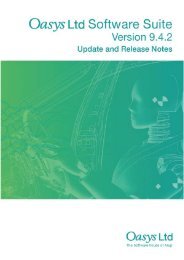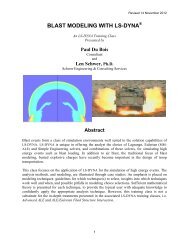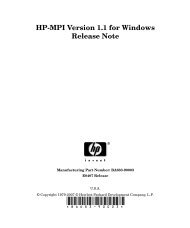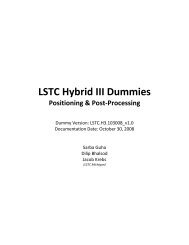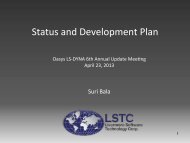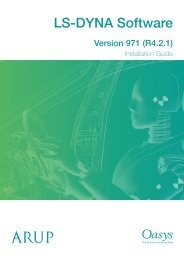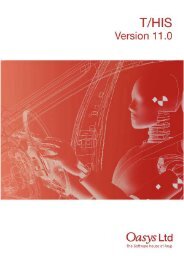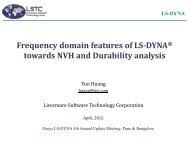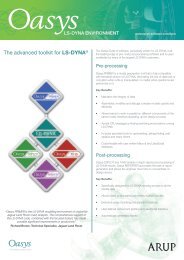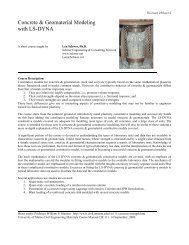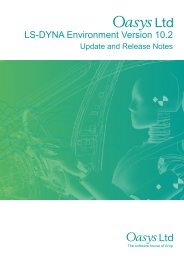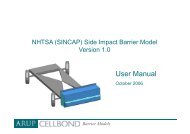Oasys LS-DYNA Environment 8.1 VOLUME 3 ... - Oasys Software
Oasys LS-DYNA Environment 8.1 VOLUME 3 ... - Oasys Software
Oasys LS-DYNA Environment 8.1 VOLUME 3 ... - Oasys Software
Create successful ePaper yourself
Turn your PDF publications into a flip-book with our unique Google optimized e-Paper software.
<strong>Oasys</strong> <strong>LS</strong>-<strong>DYNA</strong> <strong>Environment</strong>: User Guide (Version <strong>8.1</strong>)<br />
INTERIOR CONTACT<br />
Interior contact is used with meshes of very soft solid elements (eg foams) which are prone to<br />
invert under severe loading conditions. It is equivalent to a single surface contact in which<br />
contact segments of a finite thickness are attached to every internal and external solid element<br />
face. When the elements are severely crushed, these segments contact each other and resist<br />
further crushing, thus preventing element inversion (negative volumes).<br />
An alternative method is to coat the outer surfaces with null shell elements, and define contact<br />
between the null shells.<br />
OUTPUT<br />
Two options are available for recovering forces on contact surfaces.<br />
Time histories of total force against time for surface-to-surface and nodes-to-surface contact<br />
types can be obtained from the .XTF file via OASYS T/HIS. This output is always generated<br />
automatically. The forces are time-averaged over the interval between outputs.<br />
Plots of the contact stress distribution can be obtained by requesting a .CTF file when submitting<br />
a job. In this case contact stresses are dumped to the .CTF file at the same time as complete state<br />
data is dumped to the .PTF file. Contact stresses (which are instantaneous values, not timeaveraged)<br />
can then be plotted by OASYS D3PLOT.<br />
The total force on a single surface contact is zero by definition, since the action and reaction of<br />
every penetrating node is included. However, the total force on any subset of a single surface<br />
contact can be obtained using the *CONTACT_FORCE_TRANSDUCER option. This contact<br />
type does not generate any force itself: it outputs the total force due to all the contacts on the<br />
slave set to which it refers.<br />
CONTACT SEARCH METHODS<br />
There are two methods used by <strong>LS</strong>-<strong>DYNA</strong> for detecting which segment is being contacted by<br />
each node. Further details are given in the theory manual. In summary, the methods are:<br />
- Mesh Connectivity Tracking, in which neighbouring segments can be identified because<br />
they share nodes. When one segment is no longer contacted by a node, the neighbouring<br />
segments are checked.<br />
- Bucket sort, in which the 3-D space occupied by the contact surface is divided into cubes<br />
("buckets"). Nodes can contact any segment in the same bucket or a next-door bucket.<br />
The Mesh Connectivity method is used by contact types 3, 5, 8, 9 and 10 (unless SHLTHK on<br />
*CONTROL_CONTACT is non-zero). The main disadvantage is that the mesh must be<br />
continuous for the contact surface to work correctly. These contacts are rarely used.<br />
Page 9.6



